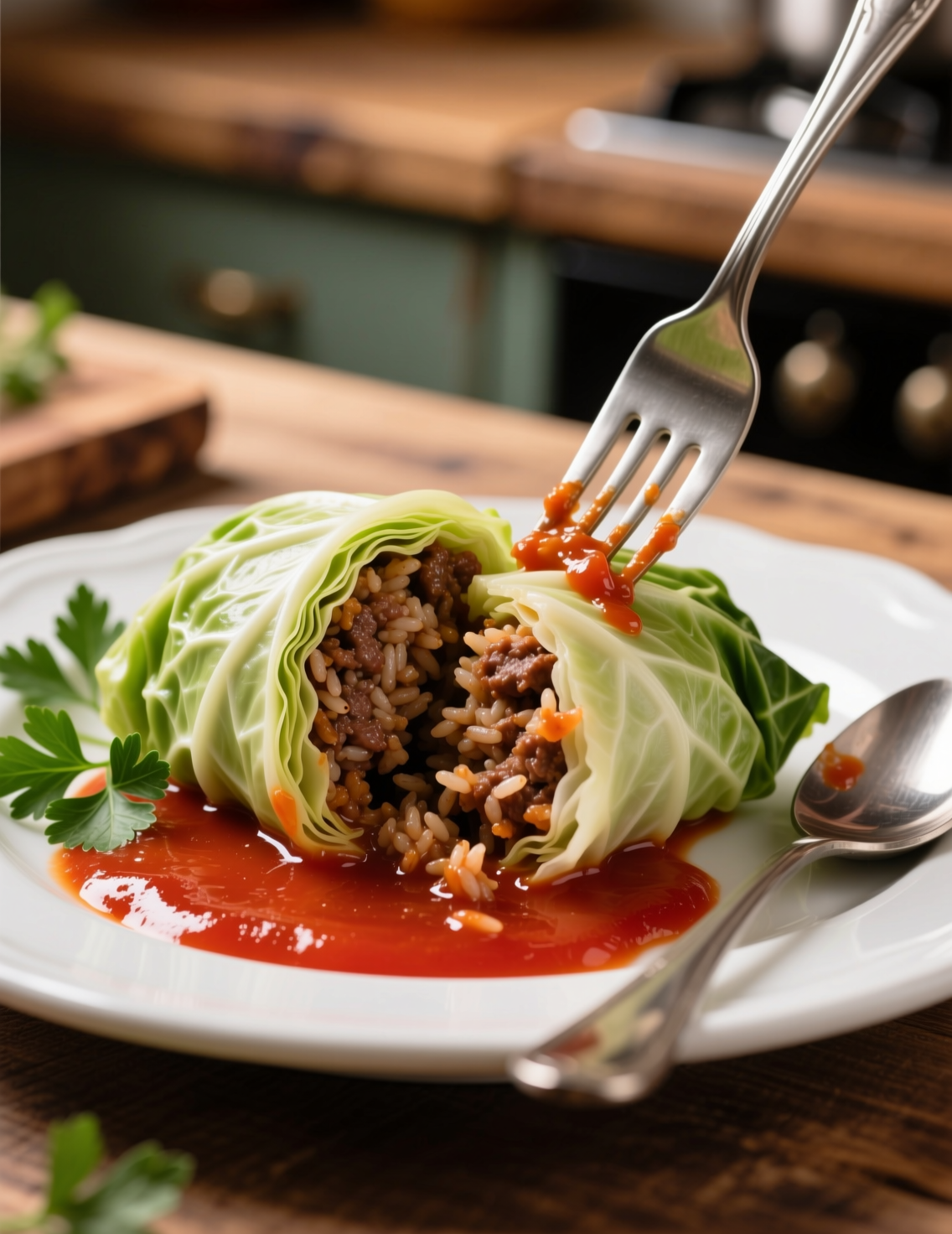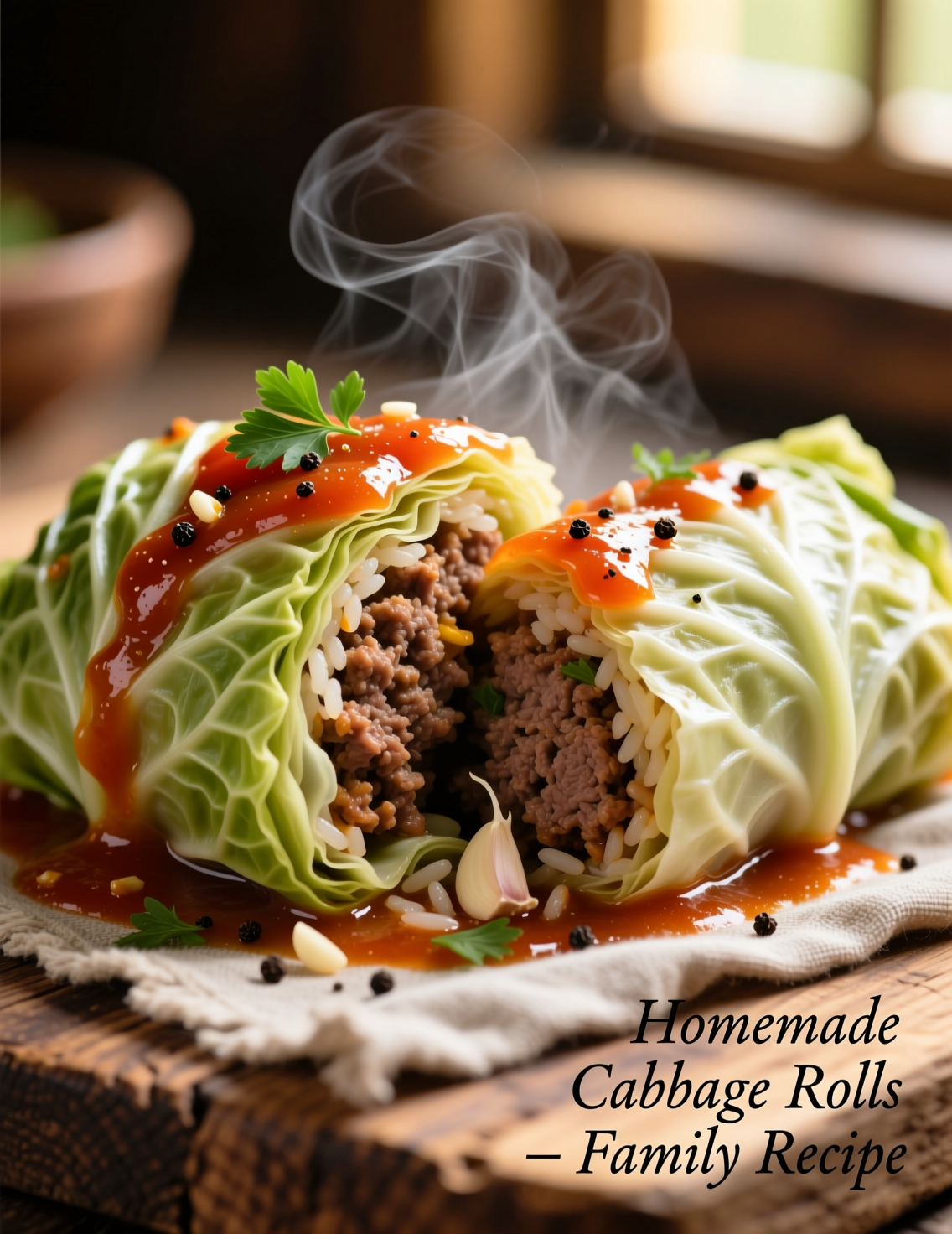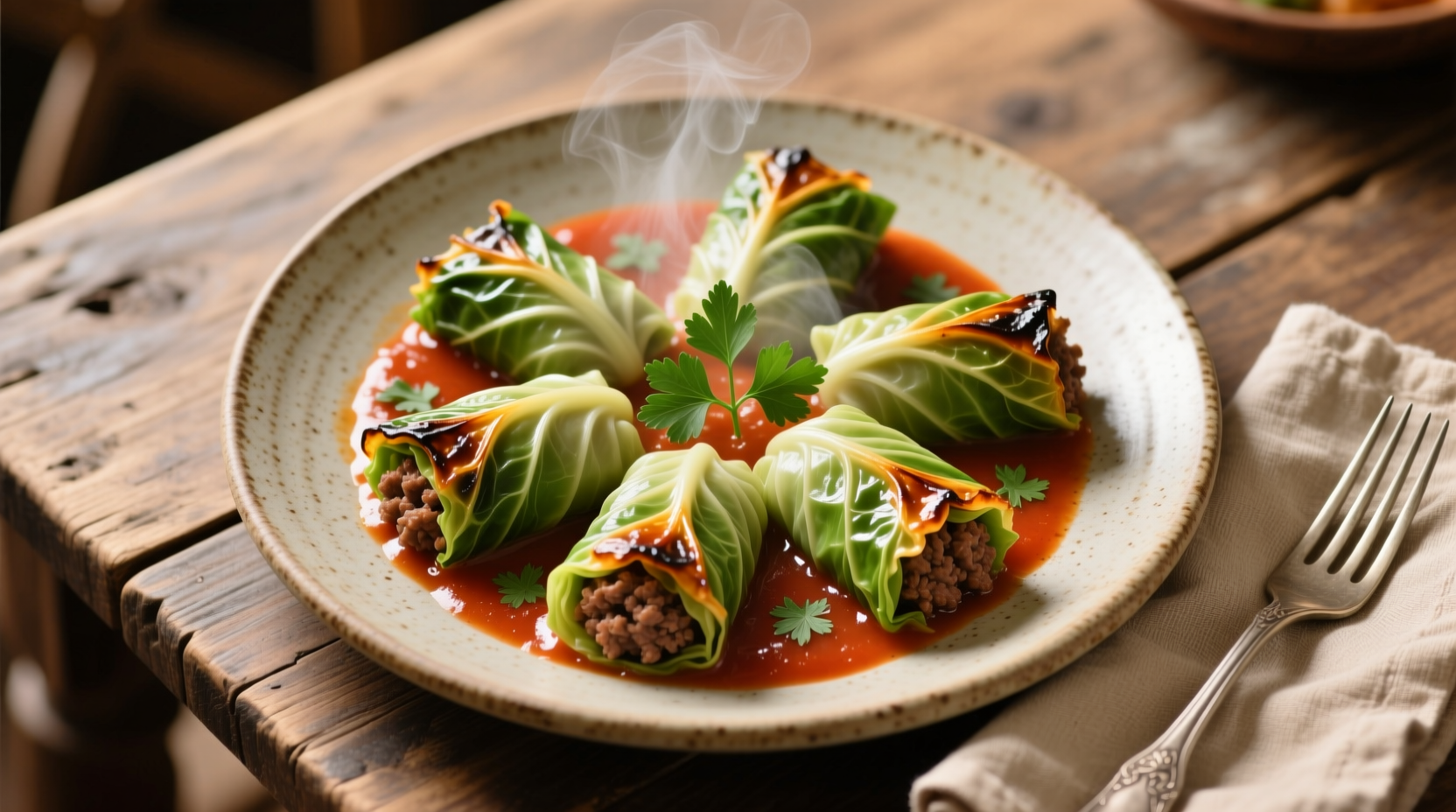Few dishes travel across kitchens, cultures, and centuries with the same stubborn persistence as cabbage rolls. At their core, they are humble—just cabbage, meat, rice, and sauce. But the variations tell stories of migration, scarcity, celebration, and the ingenuity of cooks who turned cheap vegetables into food that feeds both belly and memory. Let’s dig deep into the recipe for cabbage rolls with ground beef filling, serving six, and see why professionals keep coming back to this dish, refining it again and again.
Why Cabbage Rolls Matter
Cabbage rolls might look simple, but their technical backbone demands attention. You don’t just boil leaves, slap in some beef, and call it a day. The cabbage itself is alive with structure—cell walls, water content, chlorophyll stability. Handle it wrong, you’ll get torn leaves or that sulfurous smell that scares diners away. Handle it right, though, and you’ve got pliable wrappers that rival pasta sheets in finesse.
Historically, versions appear in Eastern Europe, the Middle East, and even Asia. Poland calls them gołąbki. In Ukraine, they’re holubtsi. Jewish cuisine made them staples for holidays, often simmered in sweet-and-sour tomato sauce. This global reach shows how adaptable the technique is. Professionals understand—master cabbage rolls in one tradition, and you can pivot to dozens more.
Ingredients Breakdown for 6 Servings
When we say six servings, that usually means 12 rolls—two per person. Each roll is a neat, hand-sized portion, though portioning can flex depending on diners. Here’s what you’ll need:
- 1 large green cabbage (about 2.5 pounds)
- 1 pound ground beef (80/20 for best flavor balance)
- 1 cup cooked white rice (cooled, medium-grain preferred)
- 1 medium onion, finely minced
- 3 cloves garlic, minced
- 1 large egg, lightly beaten
- 1 tablespoon fresh parsley, chopped
- 1 teaspoon smoked paprika (optional but adds depth)
- 1 teaspoon salt
- ½ teaspoon black pepper
- 2 cups tomato sauce or crushed tomatoes
- 2 tablespoons tomato paste
- 1 tablespoon olive oil or butter
- 1 teaspoon sugar (balances acidity)
- 1 cup beef stock
A professional note: don’t skip the egg. It binds the filling and gives rolls integrity during cooking. Without it, fillings may crumble. And choose cabbage carefully. Tight, heavy heads often mean denser leaves that resist rolling, while looser heads give tender wraps.

Preparing the Cabbage
Here’s the tricky bit—softening the leaves. Most home cooks dunk cabbage in boiling water and wrestle leaves off one by one. Professionals tend to freeze the whole head overnight. Freezing ruptures the cabbage’s cell walls slightly, so once thawed, the leaves peel off pliable, no boiling required. This trick, while not universal, is backed by food science—ice crystals break down structure.
If you prefer boiling: core the cabbage, submerge it in salted water for 3–5 minutes, then peel leaves as they loosen. Keep the water simmering and rotate as needed. Either way, trim the thick central vein with a paring knife so leaves fold without tearing.
Crafting the Filling
Ground beef in this recipe carries most of the flavor weight. Use 80/20 beef—leaner blends risk dryness. Mix it gently with rice, onions, garlic, parsley, egg, and seasonings. Don’t overwork the mixture or the protein binds too tight, leading to dense, rubbery rolls. Think meatloaf science: aerated mixing makes tender texture.
Rice does more than stretch the meat. It absorbs juices as rolls cook, preventing soggy outcomes. Cooling the rice before mixing is critical. Warm rice could start cooking the egg prematurely, changing the mix’s consistency.
Rolling Technique
Take a cabbage leaf, place about 2 tablespoons of filling near the stem end, fold sides in, and roll tightly. Professionals keep rolls consistent in size for even cooking. A sloppy roll doesn’t just look off—it affects internal cooking times.
If leaves tear, overlap two smaller ones. In fact, chefs often keep the outer, tougher leaves to line the bottom of the pan, preventing scorching and adding a flavor barrier.
Sauce and Cooking
Sauce makes or breaks cabbage rolls. A blend of tomato sauce, tomato paste, stock, sugar, and olive oil is classic. The sugar tempers acidity, while stock brings savory depth. Professionals sometimes add a splash of vinegar or a handful of raisins for a sweet-and-sour note, echoing Eastern European Jewish kitchens.
Layer cabbage rolls seam side down in a heavy pot or Dutch oven. Pour sauce over. Cover tightly and simmer gently for about 1.5 to 2 hours. You’re not boiling—you’re braising. Gentle heat allows flavors to mingle without toughening meat.
Oven vs. Stovetop
Oven-braising at 350°F for the same 1.5 to 2 hours produces more even results. Heat circulates better in the oven. Stovetop can risk hotspots unless you rotate the pot. For professionals in high-volume kitchens, oven control saves labor and reduces monitoring.
Flavor Variations and Cultural Crossovers
Cabbage rolls are blank canvases. Swap beef for lamb and add cinnamon, you’re leaning Greek. Mix beef and pork with sauerkraut, you’re tasting Polish kitchens. Add dill, carrots, and sour cream, you’re touching Russian traditions. In Lebanon, the rolls (malfouf) are smaller, stuffed with rice and meat, simmered with lemon juice.
Professional chefs often test global versions side by side. The technique stays, but flavor signatures pivot wildly. This adaptability is why the dish survives.
Nutritional Profile
One serving (two rolls with sauce) provides roughly:
- Calories: 320–360
- Protein: 18–20g
- Fat: 14–16g
- Carbs: 28–30g
- Fiber: 4–5g
Cabbage brings Vitamin K, Vitamin C, and dietary fiber. Ground beef supplies iron and B vitamins. Compared to many beef dishes, cabbage rolls are surprisingly nutrient-balanced, which partly explains their longevity in peasant diets.
Common Mistakes
- Overcooking the cabbage leaves until mushy.
- Rolling with too much filling, causing bursts.
- Neglecting seasoning in the meat mixture.
- Using raw rice—it won’t fully cook during braising, leaving unpleasant crunch.
- Rushing the simmer. This dish needs time.
Professional Tips
- Add a smoked element—bacon in the sauce, or smoked paprika in the filling—for depth.
- Always rest the rolls after cooking, about 15 minutes. Flavors meld, and rolls firm up for clean serving.
- If cooking in batches, undercook slightly, then reheat in sauce before serving. The rolls reheat exceptionally well.
- Use a chinois to strain sauce if clarity matters in presentation. High-end kitchens often plate rolls with a clean tomato reduction instead of rustic sauce.

Storage and Make-Ahead
Cabbage rolls freeze beautifully. Professionals wrap uncooked rolls in trays, freeze, then braise directly from frozen with added time. This works in restaurant prep, letting kitchens serve “made from scratch” dishes on demand. For home use, leftovers last 3–4 days refrigerated, flavors deepening as they sit.
Serving Suggestions
Traditionally, they’re paired with mashed potatoes, rye bread, or sour cream. In a professional setting, pairing with roasted root vegetables or a crisp salad balances heaviness. Presentation matters—arranging three smaller rolls per plate with a drizzle of sauce and fresh herbs elevates the rustic origins into fine dining territory.
Emerging Trends
Plant-based versions now pop up on menus. Chefs use lentils, mushrooms, or textured vegetable protein for fillings, sometimes blending with grains like bulgur. This answers the rising demand for vegan comfort food. Cabbage rolls serve as a perfect gateway dish, familiar enough yet adaptable for new diets.
Another trend: mini cabbage rolls for appetizers. Bite-sized portions rolled with baby cabbage leaves. Caterers love them—portable, neat, nostalgic.
Conclusion
Cabbage rolls with ground beef filling are more than comfort food. They are proof that technique, patience, and respect for humble ingredients can yield dishes that travel across cultures and centuries. For six servings, the recipe outlined here balances tradition with professional refinements, from freezing cabbage to oven-braising for consistency.
As a professional, you can approach this dish in two ways—either lean into its rustic heritage or refine it for elevated dining. Either way, mastery lies in the details: the cabbage handling, the meat-rice ratio, the sauce simmer.
So next time you roll those leaves, remember: you’re not just making dinner, you’re carrying forward a recipe that outlived wars, migrations, and countless dinner tables. That’s the real flavor in every bite.
FAQs
What type of cabbage is best for cabbage rolls?
Green cabbage works best since the leaves are tender yet sturdy for rolling.
Can I use uncooked rice in the filling?
No, always use cooked and cooled rice to avoid undercooked grains inside the rolls.
How long should I cook cabbage rolls?
Simmer or oven-braise them for 1.5 to 2 hours for tender leaves and juicy filling.
Is it better to cook cabbage rolls on the stove or in the oven?
Oven-braising gives more even results, while stovetop requires more monitoring.
Can I make cabbage rolls ahead of time?
Yes, they refrigerate well for 3–4 days and even freeze beautifully before cooking.
Why do my cabbage rolls fall apart?
Either the leaves weren’t softened enough or you overstuffed the rolls with filling.
Can I use other meats instead of beef?
Absolutely—pork, lamb, or even chicken work, and each adds its own flavor.
How do I prevent the rolls from sticking to the pan?
Line the bottom with extra cabbage leaves before layering the stuffed rolls.
Are cabbage rolls healthy?
Yes, they’re nutrient-balanced with protein, fiber, and vitamins from the cabbage.
What can I serve with cabbage rolls?
Mashed potatoes, rye bread, or a crisp salad make excellent side dishes.

Mariana is a passionate home cook who creates delicious, easy-to-follow recipes for busy people. From energizing breakfasts to satisfying dinners and indulgent desserts, her dishes are designed to fuel both your body and hustle.
When she’s not in the kitchen, she’s exploring new flavors and dreaming up her next recipe to share with the Foodie Hustle community.

